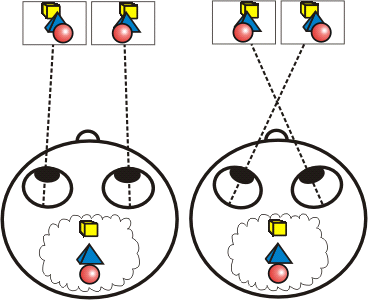5.2.2 Parallel/Cross-eyed viewing method
This viewing methods require no special devices but you need some training for your eyes. The essence of the parallel method is based on setting eyes to such angle of sight line convergence that the left eye sees a left image while the right eye sees a right image. It is vise versa for the cross-eyed method: he left eye sees a right image while the right eye sees a left one.
When using the parallel method, stereo pairs are located before eyes in the order they were taken (Fig. 13-a) and when using the cross-eyed method, they switch their places (Fig. 13-b).

a) b)
Fig. 13. Parallel and cross-eyed viewing methods
Training your eyes plays an important role: some readily see stereo images using the parallel method, some find the cross-eyed method easier. The size of images and the viewing distance are also important. It is obvious that it will be easier to view images at the distance of 40-50 cm if the distance between the centers of stereo pairs is not larger than the distance between the viewer's eyes.
In Fig. 14, you can see a stereo pair for the parallel viewing method. To be able to see the stereo effect, you should look "through" the picture as if you watch an infinitely distant object. The sight lines of your eyes will be almost parallel, while the accommodation should be adjusted to the actual distance to the image.

Fig. 14. A stereo pair for the parallel viewing method (source images from www.3dmasterkit.com by Piotr Nawracala)
In Fig. 15, you can see a stereo pair for the cross-eyed viewing method. To be able to see the stereo effect, you should look at an imaginary object in front of the image, the sight lines will intersect in this case and the accommodation should be adjusted to the actual distance to the image.

Fig. 15. A stereo pair for the cross-eyed viewing method (source images from www.3dmasterkit.com by Piotr Nawracala)